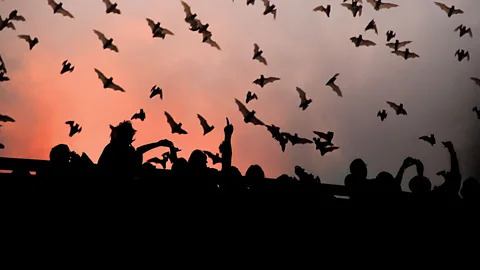
These nocturnal cave dwellers are cherished in the Lone Star state, which is home to the world’s largest bat colony and more bat-viewing sites than anywhere else in the country.
Texas has a close relationship with the bat.
In 1995,
the Mexican free-tailed bat became the state’s official flying mammal. In 2010,
the state capital, Austin, adopted the bat as its official animal emblem. While
historically, bats have had a bad reputation around the world, in Texas, these
nocturnal cave dwellers are loved and cherished.
Popular
myths have pegged bats as blind, disease-carrying bloodsuckers. In reality,
the flying mammals can see well, are very clean and feast primarily on insects.
Only three
bat species, out of more than 1,200 worldwide, eat blood from animals, and
those same species have an enzyme in their saliva that can be used as a medicinal
blood-clot dissolver to treat strokes in humans.
The bats’
popularity in Texas has a lot to do with their diet.
Bats eat mosquitoes and insects that destroy agricultural crops. A 2011 study
that was published in Science magazine study found that
insect-eating bats save the US agricultural industry between $3 billion and $53
billion in pest control costs each year. There are also nectar-eating bats,
which serve as pollinators for plants including agave,
cactus, avocado, balsa wood, cashews and cloves; and fruit-eating bats, which
disperse seeds that help regenerate forests.
As well as
being worth millions of dollars to the Texan agriculture industry, these
mammals are worth millions of dollars to the state’s tourism industry. Texas is
home to the world’s largest known bat colony (in Comal County), and the world’s
largest urban bat colony (in Austin). Bat watching is a common activity, with
the Texas Parks and Wildlife Department offering more bat-viewing
sites than anywhere else in the US.
It comes as
little surprise, then, that bat
species are protected, and that batty
attractions can be found all over the vast southern state:
Congress Avenue Bridge
Every
summer night in Austin, 100,000 people watch as 1.5
million bats fly out from under the Congress
Avenue Bridge. According to the Texas Parks and Wildlife Department, the evening
flights garner $10 million in tourism revenue annually. Each August, the free Bat Fest celebrates the city’s urban bat colony with live
music, food and bat-watching.
Eckert James River Bat Cave Preserve
Located by
the James River in Mason, Texas, this
bat colony is home to around five million Mexican free-tailed bats. Visitors
can see the bats go out at night or return to the colony at sunrise, from May
to September. The summer months can be an exciting time to visit as this is
when pregnant female bats give birth to single pups.
Moody Gardens
Moody Gardens on Galveston Island is a
large complex comprising science exhibits, an aquarium, a white-sand beach, an
IMAX cinema, a golf course, a horticultural therapy facility and a hotel and
spa. One of its main attractions, the Rainforest Pyramid, is home to 1,000
species of plants and animals from all over the world, all contained in a
10-storey, pyramid-shaped glass building. In addition to an impressive exhibit
of American bats, visitors will see rainbow boas, giant otters, ocelots and
sloths.
Clarity Tunnel
In Caprock
Canyons State Park, set among beautiful formations of exposed red
sandstone, an abandoned railroad tunnel called Clarity
Tunnel is home to 500,000 bats between late April and mid-October. About
100 miles southeast of Amarillo, Caprock Canyons is also home to the largest
herd of bison in the Texas state park system. The park has a number of hiking
and biking trails within its 15,000 acres, including the Trailway, converted
from the old railroad system.